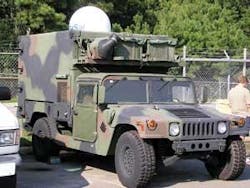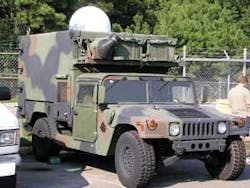ViaSat demonstrates mobile broadband technology for command and control
By John McHale
CARLSBAD, Calif. - Engineers at ViaSat demonstrated the equivalent of a DSL connection inside a moving military Humvee during the Command and Control On-the-Move (C2OTM) demonstration by the U.S. Joint Forces Command (USJFCOM) Joint C4ISR Battle Center.
The command and control network vehicle came through a prototyping partnership with the Battle Command Battle Lab (BCBL) at Fort Gordon, Ga. The C2OTM demonstration was part of the USJFCOM role as “the transformation laboratory” that accelerates the military’s adoption of commercial technologies.
“To say they were impressed I think is an understatement. They’ve seen that it’s real and it works,” says Navy Lt. Cmdr. Steve Fahey, C2OTM project lead at the Joint Systems Integration Command (JSIC). “Usually the joint force commander has to trade connectivity for mobility and that forces commanders to go without the battle space awareness they want. This technology gives them the same capability and applications on the move as they have in their offices.”
The new system is based on ViaSat’s ArcLight technology, which uses a spread spectrum waveform similar to CDMA, says Ric Vandermeulen, director of Government Broadband at ViaSat. The mobile satellite modem also can pair with ViaSat’s KG-250 in-line network encryptor to secure communications up to Top Secret levels.
When the operational system is complete, a low-profile vehicle-mounted antenna mounted on their vehicles is designed to enable commanders to receive secure real-time, broadband information via satellite feeds from their headquarters. Data speeds during the demo were 3 megabits per second inbound and 256 kilobits per second out from the vehicle.
A streaming video projection of the driver’s perspective from the moving vehicle provided a backdrop to a demonstration which included two-way audio, a virtual whiteboard, web portal access, common operational picture (COP) track displays, and a simultaneous chat session between a simulated headquarters, the Humvee, and a forward deployed team in Iraq.
“This demo is part of USJFCOM’s mission to evaluate commercial-off-the-shelf (COTS) products for tactical utility enabling accelerated introduction of transformational capabilities to the warfighter,” Vandermeulen says.
The charter for the JFCOM JSIC is to introduce new transformational technologies quickly for joint forces use. In this case the ViaSat mobile satellite system was introduced into commercial markets just within the past six months, ViaSat officials say.
The goal is to cut the government procurement cycle from as long as ten years to a matter of months, ViaSat officials say. C2OTM is in the proof of concept phase and is scheduled for completion in October. Future steps are expected to lead to development of an operational prototype and eventually a field-ready system.
ArcLight technology
“There are two key ViaSat-exclusive technologies behind the ArcLight system,” says Bruce Rowe, public relations director at ViaSat. The first is PCMA (Paired Carrier Multiple Access). “This is a frequency re-use technique that allows both transmit and receive signals in satellite communications to occupy the same bandwidth. There is both an asymmetric (A-PCMA) and symmetric version of PCMA. In the case of ArcLight, A-PCMA enables multiple, lower rate inbound channels to occupy the same physical bandwidth as the high-data-rate DVB, outbound transmission from the hub. Other systems would typically use two transponders or two chunks of bandwidth - one for outbound, one for returns - so the ArcLight system can cut bandwidth use by up to 50 percent, though it is typically less than that.”
The second is CRMA (Code Reuse Multiple Access), Rowe continues. “This is the spread-spectrumtechnology that provides a couple of benefits. One is that using the spread spectrum coding you can apply more power per bit, so small antennas can be used without interference. The other is that you get quicker access to the network because there is no TDMA or other timing scheme that terminals have to wait for. It is truly always-on.
“So it is PCMA that lets you overlay the signals, and CRMA that is the real driver of the small antennas - and just to be sure, the [Coalition Military Network mentioned below] does not use the ArcLight technology,” Rowe says.
Internet Protocol
ViaSat Internet Protocol products are already in commanders’ hands through the U.S. military’s multiyear, multibillion-dollar plan to build one integrated network based on the Internet Protocol (IP).
TCP/IP (transmission control protocol/Internet protocol), developed under contract from the U.S. Department of Defense (DOD), lays out the rules of how the Internet formats and transmits data. TCP controls how data bytes move, and makes sure the information received is correct, while IP serves as the electronic post office by ensuring that messages get to the right address or addresses
ViaSat LinkStar and LINKWAY IP-based satellite networking products, widely used in commercial enterprise networking, are the core networking technology for the Coalition Military Network (CMN), fielded by Lockheed Martin for U.S. Central Command (USCENTCOM), ViaSat officials say. Rather than multiple tactical Satcom units, the new commercial technology, under the Kuwait Iraq command, control, communications, and computers (C4) commercialization (KICC) project, is creating a permanent communications infrastructure that closely matches the capabilities of the military’s future Global Information Grid (GIG).
IP technology will give military commanders improved situational awareness - the faster communication will help create real-time pictures of a battlefield, knowing where the enemy and U.S. troops are at all times, Vandermeulen says.
The CMN is designed to support more than 1,000 telephone lines as well as fast “cable modem-like” data access to the coalition Wide Area Network (WAN) backbone for USCENTCOM, one of five combatant commands worldwide. In addition, the direct terminal-to-terminal connectivity uses only a single satellite hop that reduces satellite delay by 50 percent.
The success and capabilities of the network has led USCENTCOM to seek broader U.S. military acceptance and approval for the ViaSat commercial satellite networking system. Beginning in August, the LinkStar/LINKWAY bandwidth-on-demand system entered certification programs through the Joint Interoperability Test Command (JITC), funded by USCENTCOM, and the Joint User Interoperability Communications Exercise (JUICE), funded by the Defense Information Systems Agency (DISA). The certifications are expected to make it easier for military forces to begin wider deployment of the networking architecture, ViaSat officials say.
LINKWAY and LinkStar terminals include dynamic bandwidth resource allocation (DBRA) technology that shares bandwidth among remote stations and adjusts the size of the satellite channel to match data traffic. According to Lockheed Martin, the bandwidth efficiency improvement feature reduces satellite leasing requirements by approximately 60 percent - an annual cost savings of $12 million - compared to the dedicated, single-channel networks they replace.
Other implementations of ViaSat commercial satellite IP networking products include systems for Joint Combat Camera teams, Stryker brigades, 3rd Infantry Division and U.S. forces in Korea.
“The government will buy into the IP stuff in the next two to three years,” Vandermeulen says. ViaSat is part of the Lockheed Martin team bidding on the Transformational Communications MILSATCOM Program, which will make use of IP technology.
A Lockheed Martin Space Systems/Northrop Grumman team will compete with a team led by Boeing Satellite Systems in El Segundo, Calif., for the contract, which will be awarded in 2006 by the MILSATCOM Joint Program Office at the U.S. Air Force Space and Missile Systems Center at Los Angeles Air Force Base, Calif. This effort will culminate with a contract in 2006 and satellites launched in 2011.

